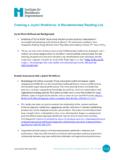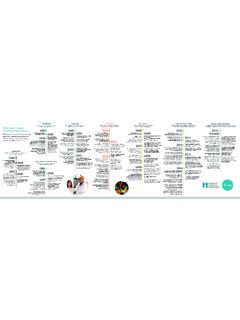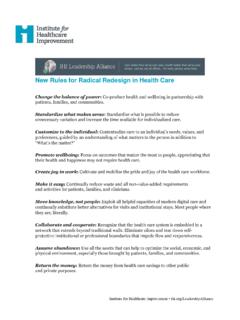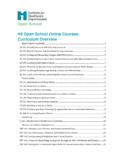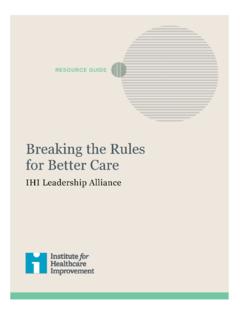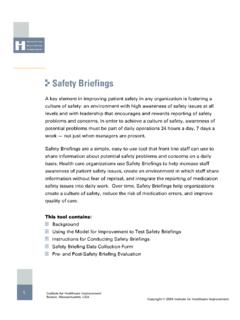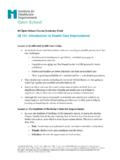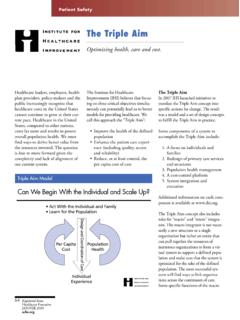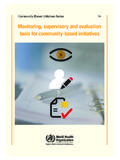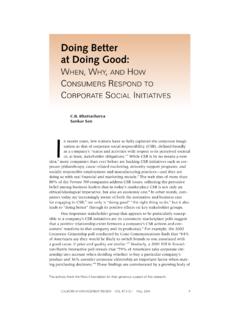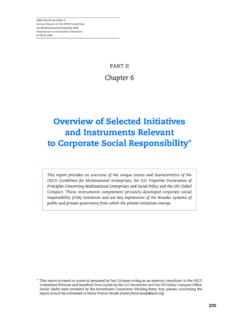Transcription of The Financial Impact of Readmissions - IHI
1 10/5/20101 The Financial Impact of ReadmissionsA STAAR Initiative WebinarAmy Boutwell, MD, MPPB arbara Balik, RN, EdDMay 12, 2010 Agenda Discuss: Why do this analysis? Describe the approach of the roadmap Present key findings from 16 analyses Ask you to test the roadmap & share learning on 5/26/10 webinar10/5/20102 Why do this analysis? Myths and back of the envelope calculations We stand to lose when Medicare stops Readmissions are already a Financial loser for Medicare doesn t pay for Hospitals will be able to replace low acuity Readmissions with higher acuity Add data and dollar signs to conventional wisdomWhy do this analysis? Cautionary tales from successful efforts in the past Research efforts stopped after grant funding expired Pilot programs ceased after start up funds spent Cost-effective hospital based programs discontinued due to Financial Impact on hospital bottom-line Both the invested human resources invested to provide better service AND Reduced volume We work in an uncertain economic climate A CFO noted that when we hit our next Financial rough spot, I know what FTEs I ll be looking to reduce.
2 10/5/20103 Why do this analysis? The challenge: But even when hospitals find ways to greatly reduce the return trips, saving money for Medicare and other insurers, their efforts go unrewarded. In fact, because insurers typically pay hospitals to treat patients not to keep them away by keeping them healthy hospitals can actually lose money by providing better care. Empty beds mean lost revenue. (Abelson, R. Hospitals Pay for Reducing Costly Readmissions , NYT, May 9, 2009.)Why do this analysis?The challenge: Berkshire Medical Center has successfully reduced heart failure Readmissions . Regular clinic visitors had a 30-day readmission rate of about 3 percent in 2008, compared to a national average of percent among heart failure patients. However, financially, the hospital lost about 30 heart failure admissions in 2008 or about $225,000 in revenue (Winslow, R.)
3 And Goldstein, J., Cutting Repeat Hospital Trips Simple Idea, Hard to Pull Off, WSJ, July 28, 2009.) 10/5/20104 Why do this analysis?Forewarned is forearmed Use your data as the starting point for an informed clinical and Financial plan to support successful efforts to reduce avoidable Readmissions We present this information to support and inform your hospital s efforts to improve the quality, safety, and patient experience of individualsApproach1. Asked voluntary hospital finance leaders if they had performed this analysis and if it would be informative for them2. Hospital finance leader partnered with a clinical leader to look at one patient s story in detailPersonal, clinical and Financial story3. Financial leader analyzed revenue, expenses, and margin associated with the entire experienceIdentified unique factors for the hospital payment types, capacity constraints, allocation of overhead, efforts to lower overhead, Readmissions initiatives, Conducted1 -2 interviews the process the lessons questions and challenges to the analysis until participants were confident in their process and findings; use it with their colleagues5.
4 STAAR faculty compiled lessons into case studies and drafted the roadmap tool 10/5/20105 Interview Questions What percentage of your daily inpatient census is 30 day all cause Readmissions ? What types of patients are in observation status? What Financial variables do you look at when examining the Impact of Readmissions ? Revenue, expenses, direct and indirect costs, variable and fixed costs, etc? What is the average directand totalmargin per patient? How does your organization allocate indirect costs? If your hospital were to reduce Readmissions (30%, 50%), which costs could be influenced and which would remain fixed? Is there excess demand in your hospital service area? Would your organization be able to backfill these beds if readmits were reduced?STAAR Financial Impact Analysis the all-cause 30 day readmission rate for the hospital and the percentage of the average daily census due to readmitted patients.
5 2. Partner Financial Lead with Clinical Lead and review the personal, clinical, and Financial story of one (or more) recently readmitted patient(s). - Calculate revenue, expenses, and Analyze clinical/operational insights from this Conduct a Financial analysis on a sample set of Readmissions for a select time period (1 month, 12 months, etc). - Analyze characteristics of this sample set (payer mix, LOS, conditions, outliers, etc)- What is the average direct and total margin per readmitted patient in this sample? 4. What Financial variables does your hospital consider when examining the Impact of Readmissions ? - Revenue, expenses, direct costs, indirect costs, variable costs, fixed costs, How does your organization define direct, indirect, fixed and variable costs?- How does your organization allocate indirect costs?5. How do Readmissions to your hospital, today,influence your hospital s bottom line?
6 6. If you were to successfully reduce Readmissions by 10%, 30%, 50%, which costs would be influenced and which costs would remain fixed? 7. What is your hospital s ability to influence (reduce) fixed costs? In the near and long term? there latent demand in your hospital service area? Would you expect to keep volume stable if Readmissions decreased? What would happen to ED visits? Observation stays? 9. What there anything that surprised you about this analysis?10. Is there anything that your hospital will do differently as a result of this analysis? Institute for Healthcare Improvement 201010/5/20106 Findings One-year 30d Readmissions to System A: 49% of (non-OB) admissions to medicine 82% Readmissions to medicine 71% discharged to home 62% Readmissions Medicare patients System B: 73% all payer non-OB Readmissions were Medicare 86% unplanned (as opposed to elective)10/5/20107 Example Findings Hospital A: Average daily inpatient (non-OB) census = 80 patients 12 of 80 were patients who had been readmitted Hospital B: Numbers of patients readmitted to/from observation stays within 30 days were high.
7 He wanted to account for total patient utilization of ED, observation beds, and inpatient beds in analysisExpense$ readmits $ all ptsAverage readmitted patient revenue = $ 12, 200- Average direct costs (fixed and variable)$ 7, 800- Average indirect variable costs$ 1, 000 Average contribution margin =$ 3, 400$ 5, 500- Average indirect fixed costs $ 3, 400 Average total margin per readmitted patient = $0$ 1, 600 Hospital A: Financial Findings10/5/2010875% readmitted patients had positive contribution margin$ readmits $ system wideAverage contribution margin = $ 2, 300- Average indirect fixed costs and - indirect cost assessment for systemAverage total margin per readmitted patient = $ (900)$ (3, 000, 000)System A : Financial FindingsExpected Payments$8,049,988 Direct Costs$5,844,682 Direct Margin$2,205,306 Total Costs$8,883,059 Total Margin-$833,071 Current state 30% decline in readmissionsIndirect costs$3,038,377$3,038,377 Direct (variable) costs$5,844, $4,091, margin($833,071)(1,494,663)Yearly Financial projections assuming 30% decline in readmissions2009 30-day All-Payer Readmissions Financial VariablesHospital B: Financial Findings10/5/20109 Hospital B: Financial FindingsKey Observations Financial partners found this exercise to be valuable and highly illuminating.
8 Surprising CFO Clinical Leader partnering provided powerful joint learning CFOs offer a novel system-perspective to QI work Reimbursements for Readmissions are greater than direct costs Readmissions generate revenue, especially when hospitals do not operate at capacity Readmissions lead to a reduction in hospital volume (at least in the short term)10/5/201010 Key Observations Most costs associated with Readmissions are fixed Hospitals have high fixed-cost structures Reducing Readmissions require re-thinking fixed cost reductions Reducing Readmissions requires incorporating this quality goal into longer term Financial and strategic planning discussions This analysis can help inform payment and policy conversationsFraming the issue Most rehospitalizations are defects in care Reducing Readmissions is possible Better care transitions is the right thing to do We need to understand the short-and-long term Financial implications of reducing Readmissions to support planning for success and avoid clashing priorities These insights can stimulate innovation in building the bridge to the future of high value.
9 Coordinated healthcare10/5/201011 Next Steps Volunteer to use the Roadmap and share learning Next call: May 26, 2010 1-2p ET Agenda: Insights from hospitals who have tested the RoadmapNote: this webinar is recorded, please encourage yourcolleagues to access this material if they are interestedDiscussio
